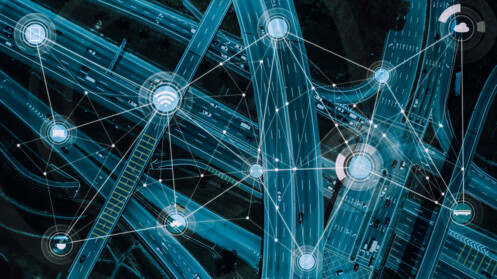Four challenges for connected cars in practice

There is currently a lot of talk about connected cars and autonomous driving. But for them to actually succeed in reality, there are some prerequisites: In the future, automakers must see themselves as digital companies and the necessary infrastructures must be expanded. Of course, data protection and security must also always be maintained. Ivo Ivanov, CEO of DE-CIX International, has formulated four of the most important challenges:
1. From driving performance to digital performance
Performance, acceleration from 0 to 100 kilometers per hour, fuel type, and fuel consumption: traditionally, driving performance and such engine parameters as these played a decisive role in the selection of a car. This could change in the future, as digitalization makes ever greater advances in vehicle design and operation. Studies by Deloitte and McKinsey suggest that in the future, the digital aspects of a vehicle will play a much greater role in purchasing decisions. Software will become an important differentiator in the market. The trend is moving towards “everything from a single source” for the handling of car-related data: classic carmakers are becoming software developers, and on the other hand even digital pioneers like Apple are trying their hand at carmaking.
2. The question of data sovereignty
The trend toward an integrated offering (vehicle and software from the same manufacturer) must also be seen against the backdrop of data usage and data protection. The data that connected cars generate en masse is a valuable asset that no one wants to lose control over. But even more important is not to jeopardize the trust of customers. Anyone who opts for a connected vehicle wants the manufacturer to handle their data with great care. Should problems arise here, the reputation of established brands would be seriously jeopardized. Whether through in-house development or in collaboration with trusted third parties, car manufacturers must be able to guarantee that data protection and control of the data is always, without question, maintained. The best way to to achieve this is through a Closed User Group (CUG) i.e. a closed, private ecosystem for interconnecting all relevant parties, in which the car manufacturer can enforce and control compliance with their policies.
3. Latency – the critical factor
Latencies, i.e. delays in data transmission, are experienced in everyday life, for example, in the form of jitter and buffering when streaming videos or online games. These effects are annoying, but not critical. It’s a different story with connected vehicles: if, for example, the communication and navigation of emergency vehicles were to be impaired, serious and potentially life-threatening situations could quickly arise. If cars are to be able to drive autonomously at some point, latency will become an even more crucial safety factor. It can’t be that critical data from your car is transferred to a data center hundreds of miles away, and then back again. This is because data, like most other things, cannot travel faster than light, and thus geographic proximity becomes an essential parameter to meet the high demands of autonomous mobility. In the future, this will require small, decentralized data centers along important transport routes to ensure fast and reliable data transfer.
4. Measures for ensuring cyber security
The possibility of hackers gaining external control of a connected car is one of the worst imaginable horror scenarios of autonomous mobility. What can manufacturers do to prevent such attacks, but also less dramatic ones? Closed User Groups and peering (exchanging data) at an Internet Exchange is an ideal combination of measures for shielding sensitive data traffic of connected or autonomous cars from unauthorized access and manipulation. When peering in a secure environment like that of a Closed User Group, carmakers can ensure that the data bypasses the public Internet, keeping it much safer.
The bottom line:
Connected and autonomous cars will fundamentally transform the world of mobility. Consumer preferences will change, and established brands will need to adapt in order to remain successful. At the same time, digital infrastructure needs to be re-conceptualized and expanded to meet the increasing requirements in terms of data transmission and processing. Internet Exchanges such as DE-CIX, where all threads come together and where secure communication takes place between all stakeholders, play a central role as digital data hubs.